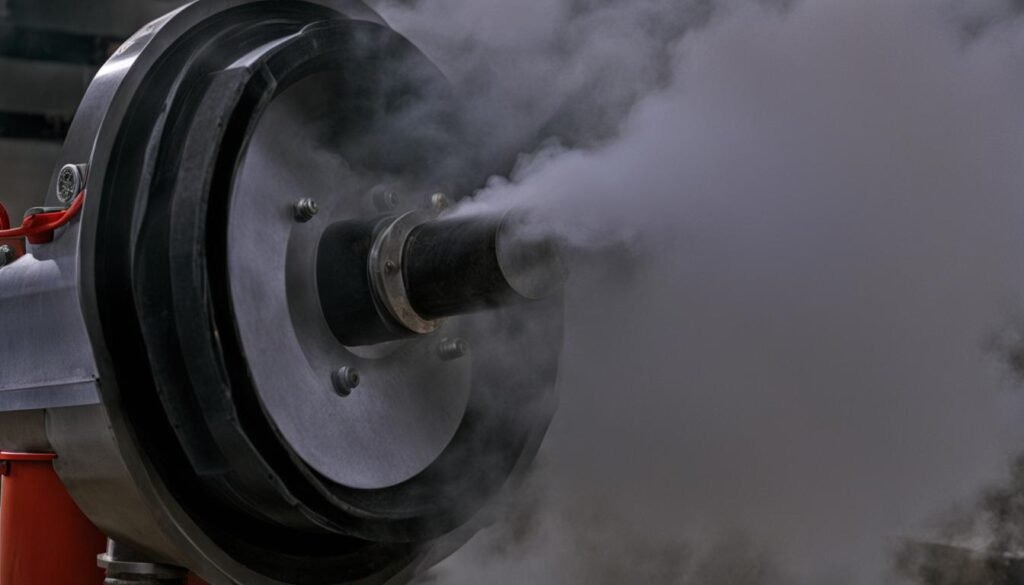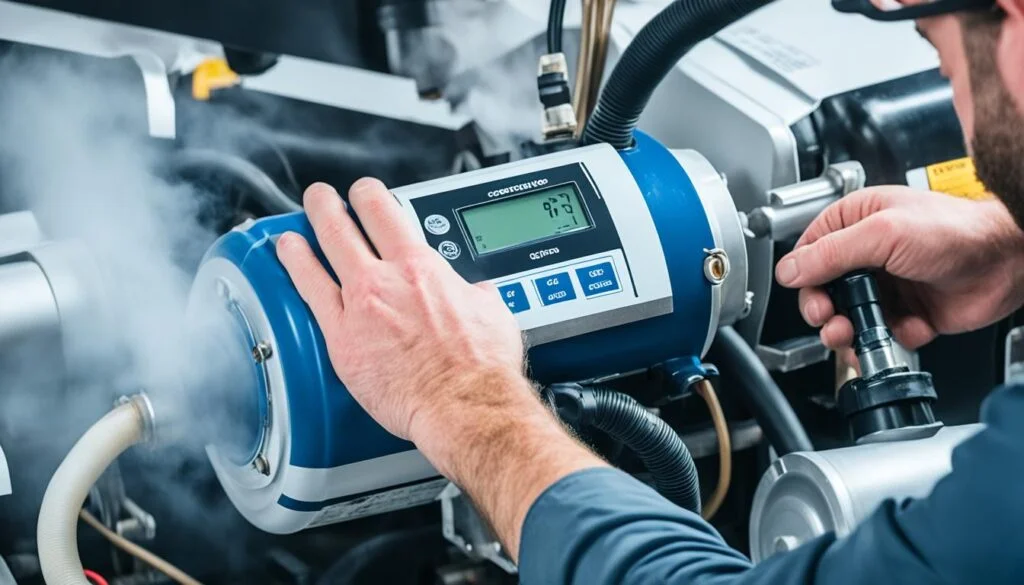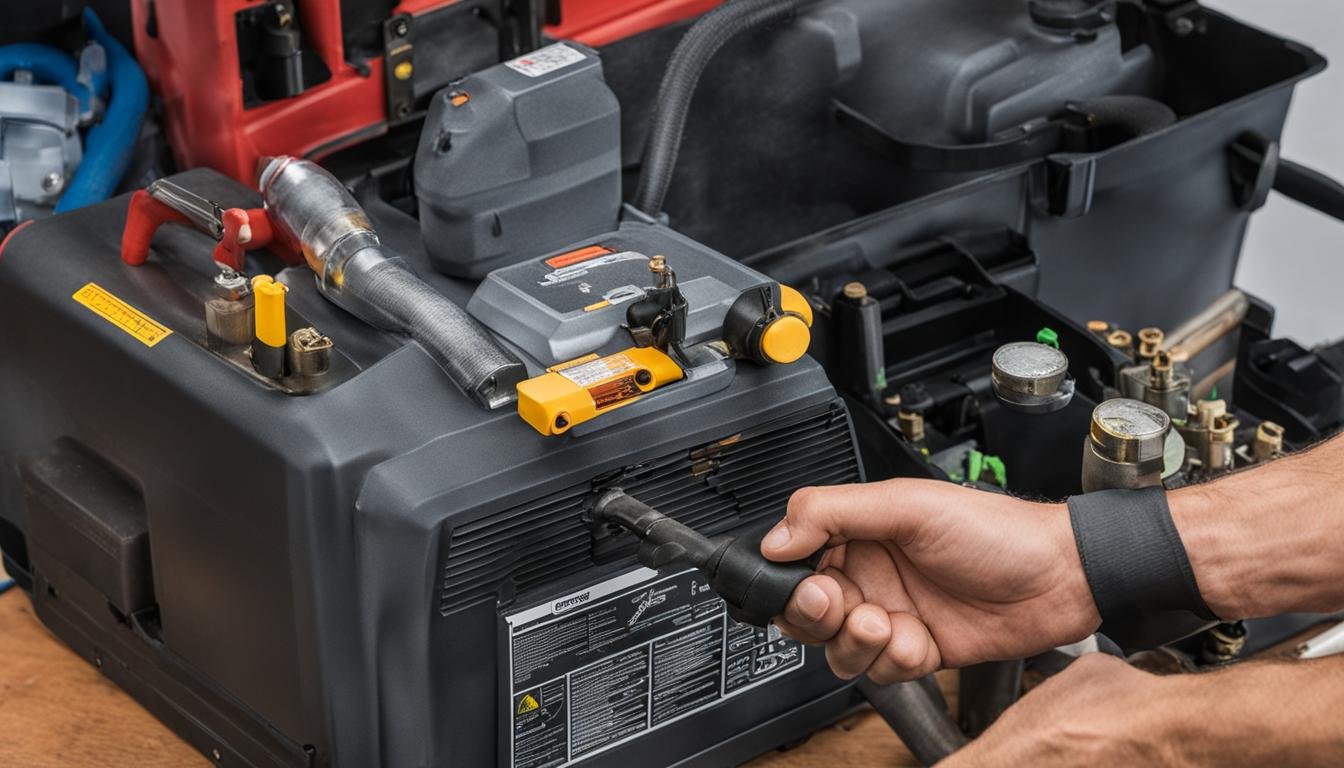When you see smoke coming from your vacuum pump, it can be a cause for concern. But before you panic, it’s important to understand that smoke doesn’t always mean there is a major issue. In fact, in many cases, the smoke is simply mechanical pump oil vapor, which is a natural by-product of creating vacuum in an oil-sealed pump.
The smoke occurs when the oil vaporizes upon contact with the air being pumped through the oil reservoir. The volume of smoke produced depends on the amount of air entering the pump. So, if you see a constant flow of smoke or mist coming from the exhaust, it could indicate a leak in the pump or an issue with the gas ballast.
Running a pump with excessive smoke or mist can lead to damage and should be addressed promptly. It’s important to monitor the oil levels in your vacuum pump and take action if you notice any smoke or unusual noises. By addressing these issues, you can extend the lifespan of your pump and ensure its optimal performance.
Key Takeaways:
- If you see smoke coming from your vacuum pump, it may be just oil vapor, not a major issue.
- Constant smoke or mist could indicate a leak or a problem with the gas ballast.
- Excessive smoke or mist can cause damage, so it’s important to address the issue promptly.
- Monitor the oil levels in your vacuum pump and take action if you notice any smoke or unusual noises.
- Regular maintenance and monitoring can extend the lifespan of your vacuum pump.
Causes of Vacuum Pump Smoking
There are several reasons why your vacuum pump may be smoking. One common cause is the continuous operation of the pump for an extended period of time, which can lead to an increase in pump temperature and the production of smoke. Rapid suction of dirt at high speed can also cause the pump to smoke. Insufficient oil in the pump or the presence of impurities can also contribute to smoking. Foreign objects entering the pump body can increase the friction coefficient and generate heat, resulting in smoke.
It’s important to stop the pump and analyze the cause of the smoke to prevent further damage. If the smoke is due to extended operation time or high-speed suction, allow the pump to rest and cool down. If there is a lack of oil, add oil to the pump. If foreign objects are present, clean the pump body and replace the contaminated oil.
Causes of Vacuum Pump Smoking
| Cause | Explanation |
|---|---|
| Extended operation time | Continuous pump operation raises temperature, leading to smoke production |
| Rapid suction of dirt | High-speed dirt suction can cause the pump to smoke |
| Insufficient oil | Low oil levels in the pump can contribute to smoking |
| Presence of impurities | Impurities in the pump can also cause smoke |
| Foreign objects | Foreign objects entering the pump body generate heat and result in smoke |
Identifying and addressing the underlying cause of the smoke will help ensure the proper functioning and longevity of your vacuum pump.

Troubleshooting and Solutions for Smoking Vacuum Pump
If you are experiencing smoke from your vacuum pump, there are several troubleshooting steps you can take to resolve the issue.
- Check the oil levels: Ensure that the oil levels in the pump are at the correct level. If the oil is low, add more oil to the pump. If the oil is contaminated, drain it and replace it with fresh oil.
- Inspect the oil mist separator: Take a look at the oil mist separator and replace it if necessary. This component plays a crucial role in reducing oil mist and preventing smoke.
- Check for leaks: Look for any leaks in the pump system and repair them as needed. Leaks can contribute to smoke production and should be addressed promptly.
- Avoid overloading with water: Make sure that the pump is not overloaded with water, as this can lead to smoking. Ensure that the water levels are appropriate for the pump’s specifications.
- Consult a professional: If none of these troubleshooting steps resolve the issue, it may be necessary to consult a professional technician who specializes in vacuum pump repairs. They can provide further diagnosis and specialized solutions for fixing the smoking vacuum pump.
Regular maintenance and inspection of your vacuum pump, along with following these troubleshooting steps, can help prevent smoking and ensure optimal performance. By addressing the issue promptly and taking preventive measures, you can extend the lifespan of your vacuum pump and avoid costly repairs.

Continue reading to learn more about understanding vacuum pump smoking and additional preventive measures to keep your pump in top condition.
Conclusion
Understanding vacuum pump smoking is crucial for maintaining the optimal performance and longevity of your pump. It’s important to note that smoke from a vacuum pump is often the result of oil vapor and not necessarily a sign of a major issue. By closely monitoring the oil levels and regularly maintaining your pump, you can prevent smoking and ensure its proper functioning.
Addressing any leaks or foreign objects that may be present in the pump system is essential in preventing smoking. Regular maintenance, such as checking and replacing the oil mist separator, will help reduce smoke production. If you encounter difficulties in resolving the smoking issue, seeking assistance from a professional technician is recommended to ensure accurate diagnosis and appropriate repairs.
Remember, prevention is key. Proactively addressing potential problems and conducting routine maintenance can significantly prolong the life of your vacuum pump. By following these preventive measures and seeking professional help when needed, you can enjoy a smoke-free and reliable vacuum pump for years to come.
FAQ
Why is my vacuum pump smoking?
When smoke is seen coming from the vacuum pump, it is often due to the mechanical pump oil vaporizing, which is a natural by-product of creating vacuum in an oil-sealed pump.
What causes vacuum pump smoking?
Vacuum pump smoking can be caused by continuous operation for extended periods, high-speed suction of dirt, insufficient oil or impurities in the pump, foreign objects entering the pump body, or overloading the pump with water.
How can I troubleshoot and fix a smoking vacuum pump?
To troubleshoot a smoking vacuum pump, check the oil levels and add or replace oil as needed. Inspect and replace the oil mist separator if necessary. Check for leaks and repair them. Ensure the pump is not overloaded with water. If the issue persists, consult a professional technician for further diagnosis and repair.
How can I prevent vacuum pump smoking?
To prevent vacuum pump smoking, regularly monitor and maintain proper oil levels, address any leaks or foreign objects, and conduct routine maintenance and inspection. This will help prolong the life of your vacuum pump and prevent smoking.





Leave a Reply